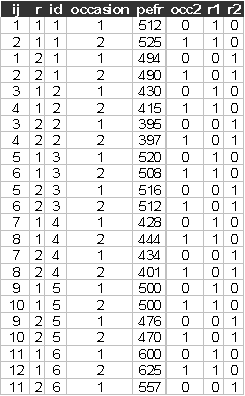Exercise L9, bivariate linear model
Bland and Altman (1986) report on a study to compare the standard Wright peak flow meter with the (then) new Mini Wright peak flow meter. The data that accompany this study (pefr.dat) contain the repeated measurements of peak expiratory flow rate (PEFR) obtained from a sample of 17 individuals. These subjects had their PFER measured twice using the new Mini Wright peak flow meter and twice using the Standard Wright peak flow meter. To avoid instrument effects being confounded with prior experience effects, the instruments were used in random order.
Data description
Number of observations (rows): 34
Number of variables (columns): 4
Variable description:
id= person identifier
occasion=occasion {1,2}
wp=Standard Wright meter PEFR
wm=Mini Wright meter PEFR
The first few rows of the data look like:

Start Sabre and specify transcript file:
out pefr.log
data id occasion wp wm
read pefr.dat
Suggested Exercise
(1) Create the dummy variable occ2, where occ2=1 if occasion
=2, 0 otherwise.
Standard Wright Meter
(1) Estimate a linear model for wp with occ2 as a covariate and allowing for the id. random effect Is occ2 significant? Are the random person
effects significant? Use 64 quadrature points to
estimate this model?
Mini Wright Meter
(2) Estimate a linear model for wm with occ2 as a covariate
and allowing for the id random effect. Is occ2 significant? Are the random
person effects significant? Use 64 quadrature points to
estimate this model?
Joint Model
(3) We have created a stacked version of the data (wm-wp.dat). The first few lines of this data look like:

The commands to read the stacked data are:
out wm-wp.log
data ij
r id occasion pefr occ2 r1 r2
read wm-wp.dat
(4) Calculate interaction effects r1_occ2 (r1 * occ2) and r2_occ2 (r2 * occ2), estimate a model for perf on r1_occ2 r1 r2_occ2 and r2, with 64 quadrature points in both dimensions. What is the significance of the correlation between the random effects of each type of meter? How does the significance of the occasion effect change when we allow for this correlation?
(5) On the basis of these data, would you be prepared to replace the Standard Wright flow meter with the new Mini Wright Meter?
References
Bland, J. M., and Altman, D., G., (1986),
Statistical methods for assessing agreement between two methods of clinical
measurement, Lancet, 1, 307-310.